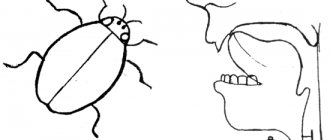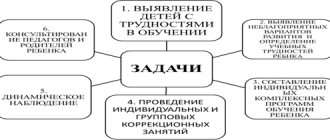Presentation “Periodization of speech development”
Voskresenskaya Marina Olegovna
Presentation “Periodization of speech development”
Periodization of speech development. Characteristics of successive stages of speech development in childhood
V. Humboldt: “Children’s acquisition of language is not the adaptation of words, putting them together in memory and reviving them with the help of speech, but the development of language ability with age and exercise.”
The process of formation of speech activity in ontogenesis in the concept of “ speech ontogenesis ”
A. A. Leontiev is divided into a number of successive
periods or “stages”
.
1st - preparatory (from birth to one year)
;
2nd - pre-preschool (from one year to 3 years)
;
3rd - preschool (from 3 to 7 years)
;
4th - school (from 7 to 17 years old)
.
The first stage of speech formation covers the first three years of a child’s life. The development of children's speech up to three years of age is in turn divided into three main stages:
1. pre-speech stage (the first year of life, in which periods of humming and babbling ,
2. stage of primary language acquisition (pre-grammatical)
- second year of life and
3. stage of grammar acquisition (third year of life)
.
A. A. Leontiev points out that the time frame of these stages is extremely variable; In addition, acceleration occurs in the development of children's speech—a shift in age characteristics to earlier age stages of ontogenesis.
Language is a system of special signs and rules for their combination. In addition to internal content, language signs also have an external form—sound and written.
A child begins language acquisition by mastering the sound form of expression of a linguistic sign.
Mastering the articulation of speech sounds is a very difficult task, and although the child begins to “practice”
in pronouncing sounds already from half a year to two months of age,
it takes him three to four years speech pronunciation In all normally developing children, there is a certain sequence in the acquisition of the sound form of language and in the development of pre-speech reactions : humming, “pipe”
, babbling and its
“complicated version”
- modulated babbling.
The child is born, and he marks his appearance with a cry. A cry is a child's first vocal reaction. Both the scream and the crying of a child activate the activity of the articulatory, vocal, and respiratory parts of the speech apparatus .
For a child of the first year of life “ speech training ”
in pronouncing sounds is a kind of game, an involuntary action that gives the child pleasure. A child can stubbornly repeat the same sound for many minutes and thus practice articulating it.
The period of walking is observed in all children. Already at 1.5 months, and then at 2-3 months, the child exhibits vocal reactions in the reproduction of sounds such as a-a-bm-bm, blb, u-gu, boo, etc. It is these that later become the basis for the development of articulate speech. All the children of the world's nations have the same buzz.
At 4 months, sound combinations become more complex: new ones appear, such as gn-agn, la-ala, rn, etc. In the process of humming, the child seems to be playing with his articulatory apparatus, repeating the same sound several times, while enjoying it . A child gurgles when he is dry, well-rested, fed and healthy. If one of your relatives is nearby and starts “talking”
with the baby, he listens to the sounds with pleasure and seems to
“pick up”
them. Against the background of such positive emotional contact, the baby begins to imitate adults and tries to diversify his voice with expressive intonation.
To develop walking skills , teachers recommend so-called “visual communication”
, during which the child peers at the adult’s facial expressions and tries to reproduce them.
In most cases, at the first manifestations of humming, his parents begin to talk to the baby. The child picks up the sounds he hears from the speech of adults and repeats them. In turn, the adult repeats the child’s “
speech ” reactions.
Such mutual imitation contributes to the rapid development of increasingly complex pre-speech reactions of the child . Pre-speech reactions , as a rule, do not develop well enough in cases where, although the child is being trained, he cannot hear himself or the adult. For example, if there is loud music in the room, adults are talking to each other, or other children are making noise, the child will very soon fall silent. There is one more important condition for the normal development of pre-speech reactions : the child must clearly see the face of an adult, the movements of the organs of articulation of the person talking to him are accessible to perception.
According to a number of experimental studies , by the age of 6 months, the sounds pronounced by children begin to resemble the sounds of their native language.
During period , the sound side of children's speech is devoid of four important features inherent in speech sounds : a) correlation; b) “fixed”
localization (
"stable"
articulation);
c) constancy of articulatory positions (there is a large and largely random “scatter”
of articulations);
d) relevance, i.e. the correspondence of these articulations to the orthoepic (phonetic)
norms of the native language.
Only during the period of babbling (which is expressed in the pronunciation of combinations of sounds corresponding to a syllable and the production of syllable series of different volume and structure) these normative features of sound pronunciation gradually begin to appear. During this period, a “syntagmatic organization”
speech:
the “structure”
of the syllable is formed, the division of the flow of speech into syllabic quanta is noted, which indicates the formation of a physiological mechanism of syllable formation in the child.
After 2-3 months, speech manifestations acquire a new “quality”
.
A unique equivalent of a word appears, namely, a closed sequence of syllables, united by accentuation, melody and unity of articulatory organs. Pseudowords do not yet have an objective reference and serve exclusively to express one or another “vital”
need or a not yet fully realized
“evaluative”
attitude towards the outside world.
With normal child development, “booming”
at 6-7 months it gradually turns into babbling. At this time, children pronounce syllables like ba-ba, dy-dya, de-da, etc., relating them to certain people around them. In the process of communicating with adults, the child gradually tries to imitate intonation, tempo, rhythm, melody, and also reproduce series of syllables; The volume of babbling words that the child tries to repeat after adults expands.
At 8.5-9 months, babbling already has a modulated character with a variety of intonations. But this process is not unambiguous for all children: with a decrease in auditory function, the babbling “fades out”
, and this is often a diagnostic symptom.
At the age of nine to ten months, a qualitative leap occurs in the child’s speech development . “normative” ones appear
, subject related words.
The range of articulations does not expand within two to three months, just as there is no attribution of sounds to new objects or phenomena: in this case, the identity of the use of a pseudo-word is ensured not only and not so much by the identity of articulation, but by the identity of the sound appearance of the whole word. At the age of 10-12 months, the child uses all nouns in the nominative case in the singular. Attempts to connect two words into a phrase (Mom, give me)
appear later
(at about a year and a half)
.
Then the imperative mood of verbs is learned (Go-go! Give-give)
.
It is traditionally believed that when plural forms are introduced, grammar acquisition begins. Depending on individual differences in the pace of psychophysical and cognitive development , all children progress differently in their language development .
"Suspense"
phonetic
development during this period “ speech ontogenesis ” (for a period of 3-4 months)
is associated with a significant increase in the number of words in the active vocabulary. A linguistic sign appears in the child’s speech. The word begins to act as a structural unit of language and speech.
A child’s assimilation of the sequence of sounds in a word is the result of the development of a system of conditioned connections. The child imitatively borrows certain sound combinations from the speech of the people around him. At the same time, mastering language as an integral system of signs, the child masters sounds immediately as phonemes. The child quickly grasps the essential features of the sounds of his language.
According to a number of studies, phonemic hearing is formed at a very early age. First, the child learns to separate the sounds of the outside world (the creaking of a door, the sound of rain, the meowing of a cat)
from the sounds of speech addressed to him.
The child actively searches for sound designations of elements of the surrounding world, catching them from the lips of adults. However, he uses the phonetic means of the language borrowed from adults “in his own way
.
It can be assumed that children use their “strictly ordered system”
.
In the process of language acquisition, a child creates his own intermediate language system. Subsequently, sonority (determined by the sonority of the voice)
becomes a contrasting differential feature
of a speech sound , which will allow the child to double his supply of consonant classes. A child is not able to borrow such a rule from adults. The reason is not that the child does not know how to pronounce, say, the sound [d] - he knows how to pronounce it, but believes that this sound can only appear at the beginning of a word. Later, this “system of rules”
is corrected, and the child
“brings”
it to the adult language system. When it comes to the phonetic side of speech, it is clear that a child does not even need to be able to pronounce a sound in order to adequately perceive its differential features.
First, the child masters the purely external structure of the sign, which subsequently, in the process of operating with signs , leads the child to its correct functional use. In general, we can talk about the formation of the articulatory apparatus only when the child reaches five or six years of age.
During the period of initial language acquisition, the volume of babbling and full-meaning words in the child’s active vocabulary expands. This stage is characterized by the child’s increased attention to the speech of others, and his speech activity . The words a child uses are most often “ambiguous”
; At the same time, the child denotes several concepts using the same word or combination.
After one and a half years, children’s active vocabulary grows; the first sentences appear, consisting of whole words and amorphous root words.
Pedagogical observations show that children do not immediately master the correct reproduction of language signs: some language phenomena are acquired earlier, others later. The simpler a word is in sound and structure, the easier it is for a child to remember. During this period , a combination of the following factors plays a particularly important role:
a) imitation of the speech of others;
b) the formation of a complex system of functional mechanisms that ensure the implementation of speech;
c) the conditions in which the child is raised (psychological situation in the family, attentive attitude towards the child, a full-fledged speech environment , sufficient communication with adults).
Analyzing the quantitative indicators of the growth of children's vocabulary during this period , we can cite the following data from pedagogical observations and psychological and pedagogical research: at one and a half years, the volume of children's vocabulary is 30-50 words, by the end of the second year - 80-100 words, by three years - approximately 300-400 words.
A characteristic indicator of the active speech development of children at this stage is also their gradual assimilation of grammatical categories.
It is possible to distinguish during this period a separate “substage of “physiological agrammatism”
when a child uses sentences in communication without the appropriate grammatical design of their constituent words and phrases.
With normal speech development, this period lasts from several months to six months.
During the pre-school period of speech development , children exhibit a variety of phonetic disorders: they skip many sounds of their native language, rearrange them, and replace them with simpler ones in articulation. These speech defects (defined by the concept of “physiological dyslalia”
) are explained by age-related imperfections of the articulatory apparatus, as well as an insufficient level
of development of phonemic perception. At the same time, a characteristic feature of this period is the children’s fairly confident reproduction of the intonation-rhythmic and melodic contours of words.
N. S. Zhukova notes that a qualitative leap in the development of a child’s speech occurs from the moment he becomes able to correctly construct simple sentences and change words by cases, numbers, persons and tenses. By the end of the preschool period , children communicate with each other and others using the structure of a simple common sentence, while using the simplest grammatical categories of speech.
Parents and educators should be informed that the most favorable and intensive period in the development of a child’s speech falls in the first 3 years of life. It is during this period that all functions of the central nervous system, ensuring the formation of a system of conditioned reflex connections that underlie the gradually developing speech and language skills , are most easily amenable to targeted pedagogical influence. If developmental at this time are unfavorable, then the formation of speech activity may be delayed.
Many parents evaluate speech development only by the degree of correct sound pronunciation. This approach is erroneous, since an indicator of the development of children's speech is the timely development in the child of the ability to use his vocabulary in verbal communication with others, in different sentence structures. By the age of 2.5-3 years, children use three to four word sentences using various grammatical forms.
Preschool stage of “ speech ontogenesis ”
characterized by the most intensive
speech development of children . There is often a qualitative leap in the expansion of vocabulary. The child begins to actively use all parts of speech; in the structure of the language ability that develops during this period .
The process of language acquisition proceeds so dynamically that after 3 years, children with a good level of speech development communicate freely not only using grammatically correct simple sentences, but also some types of complex sentences; speech utterances are already constructed using conjunctions and allied words.
At this time, the active vocabulary of children reaches 3-4 thousand words, a more differentiated use of words is formed in accordance with their meanings; children master the skills of inflection and word formation.
In the preschool period , there is a fairly active development of the phonetic side of speech, children master the ability to reproduce words of different syllabic structure and sound content. If individual errors are noted, they occur, as a rule, in the words that are most difficult to reproduce, rarely used, or are unfamiliar to children. In this case, it is enough to correct the child only 1-2 times, give an example of correct pronunciation and organize a little “ speech practice ”
in the normative pronunciation of a word, how the child will quickly introduce this new word into his independent speech.
The developing skill of speech-auditory perception helps you control your own pronunciation and hear errors in the speech of others. During this period , children develop a “sense of language”
, which ensures the correct use of all grammatical categories and forms of words in independent statements.
By the end of the preschool period of development of speech activity, children normally master developed phrasal speech , phonetically, lexically and grammatically correct. Deviations from orthoepic norms of oral speech do not have a persistent fixed character, even with appropriate pedagogical “adjustment”
on the part of adults they are quickly eliminated.
A sufficient level of development of phonemic hearing allows children to master the skills of sound analysis and synthesis, which is a necessary condition for mastering literacy during schooling .
In the preschool period, the child’s speech as a means of communication with adults and other children is directly related to a specific visual communication situation. Carrying out in a dialogical form, it has a pronounced situational character. With the transition to preschool age, the emergence of new types of activities, new relationships with adults, differentiation of functions and forms of speech occurs. The child develops a form of speech-message in the form of a story-monologue about what happened to him outside of direct contact with an adult. With the development of independent practical activity, the child begins to need to formulate his own plans and reason about the way to carry out practical actions. A need arises for speech that is understandable from the speech context itself—coherent contextual speech. The transition to this form of speech is determined, first of all, by the assimilation of grammatical forms of expanded statements . At the same time, there is a further complication of the dialogic form of speech, both in terms of its content and in terms of the child’s increased linguistic capabilities, activity and degree of participation in the process of Live speech communication .
From the age of 5-6 years, the child begins to intensively master monologue speech. In older preschool age, the situational speech characteristic of younger preschoolers noticeably decreases. Already from the age of 4, children become available to such types of monologue speech as description and narration, and at the 7th year of life - short reasoning. The statements of children aged 5-6 years are already quite common and informative; they contain a certain logic of presentation. Often elements of fantasy appear in their stories, a desire to invent episodes that have not yet occurred in their life experience.
However, children’s full mastery of monologue speech skills is possible only under conditions of targeted training. Necessary conditions for the successful mastery of monologue speech include the formation of special motives, the need for the use of monologue statements; the formation of various types of control and self-control, the assimilation of appropriate syntactic means of constructing a detailed message . Mastery of monologue speech and the construction of detailed coherent statements becomes possible with the emergence of the regulating, planning functions of speech. Research has shown that children of senior preschool age are able to master the skills of planning monologue statements. This, in turn, is largely determined by the gradual formation of the child’s inner speech. Transition to external “egocentric”
speech into internal speech normally occurs by 4-5 years of age.
Forming the skills of constructing coherent, detailed statements requires the use of all speech and cognitive capabilities of children, while simultaneously contributing to their improvement. It should be noted that mastering coherent speech is possible only if there is a certain level of development of vocabulary and grammatical structure of speech. speech work on the development of should also be aimed at solving the problems of forming a child’s coherent speech .
During the school period of speech development, the improvement of coherent speech continues. Children consciously learn grammatical rules for the design of free statements and fully master sound analysis and synthesis. At this stage, written speech is formed.
The development of a child’s speech is a complex, diverse and rather lengthy process. Children do not immediately master the lexico-grammatical structure, inflections, word formation, sound pronunciation and syllabic structure. Some groups of linguistic signs are acquired earlier, others much later. Therefore, at various stages of development of children's speech, some elements of the language are already mastered, while others are only partially mastered. At the same time, the assimilation of the phonetic structure of speech is closely related to the general progressive progress of the formation of the lexical and grammatical structure of the native language.
What happens after 3 years
The child goes to kindergarten. By this point, he knows 250-700 words - a colossal number, right? A kindergartener constructs sentences of 5-8 words and completes tasks (“put this on your neck”). He also knows his name and understands short stories and fairy tales.
Then speech develops rapidly (although in everyday life we do not notice this). For example:
- 4 years. The child uses 1500-2000 words (more than some of us know from English). Uses prepositions and conjunctions, begins to pronounce hissing sounds correctly.
- 5 years. Vocabulary 2500-3000 words. Syllable rearrangements disappear from words. All parts of speech are used in sentences.
- 7 years. A preschool child uses up to 3,500 words, many of which are figurative. And he even uses fixed expressions (“without hind legs”, “by the sweat of his brow” - sometimes it’s very funny to hear).
By the preparatory group of a preschool educational institution, a preschooler develops memory, attention and logical thinking. He can himself, in a coherent speech, explain the meaning of any concept (“winter is when it’s cold and gets dark early”). The child has the prerequisites for successful schooling.
See you soon in articles on speech development!
Speech development is one of my favorite topics. Sometimes you have to stop yourself from writing 80 pages. I will draw a conclusion from today’s article: the better a child’s development of all types of speech, the better he will perceive information when learning. And the types of speech are colloquial, monologue, dialogic, internal, passive, etc.
So what are we doing? Let’s not be lazy and purposefully chat! With purpose and arrangement. Of course, silent children can also study well. For many silent, shy people, the main dialogues take place inside.








